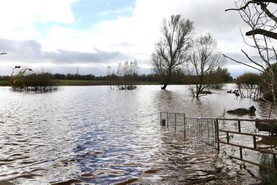A survey of NI farmers conducted by AgriSearch and the Ulster Farmers’ Union (UFU) highlights that animal performance, especially on beef and sheep farms, is likely to be negatively impacted by poorer-quality silage and high meal costs this winter.
The work followed on from a similar survey in the spring, which asked farmers about carryover fodder stocks and fertiliser purchases.
The latest survey covered a range of issues including the amount of silage made, livestock numbers this winter and whether fertiliser has been purchased for 2023. It was completed by 400 farmers, with 296 indicating that they had a beef and sheep enterprise, 145 milked cows, and 76 grew cereals. Of the 288 farmers who answered a question about silage stocks on-farm, the results suggest there is more fodder made than in previous years. That is mainly on the back of good growing conditions in the spring, which resulted in large first cuts, despite less fertiliser being used.
However, a wet May delayed cutting in many instances, so silage quality has taken a hit. Of the farmers that have analysed silage, over half described their fodder as “below average” or “far below average”.
In previous years, farmers might have compensated for that by feeding more concentrate, but high prices are likely to temper that approach.
Under 2% of beef and sheep respondents suggested they might feed more concentrate per head this winter, and fewer than one-third indicated that feeding levels would be similar to previous years.
Around one-quarter indicated they would feed a little less, and a similar proportion said they would feed a lot less, or none. With plenty of silage made, it has taken the pressure off livestock numbers. Among beef and sheep farmers, 70% said they have no plans to reduce stocking rate more than in previous years.
Dairy
On dairy farms, the fact that milk price has moved up in line with costs means the outlook for milk production this winter looks reasonably stable.
Around 70% of dairy farmers intend to keep cow numbers the same, and while some do expect to reduce their herd, that is balanced out by a similar number who intend on keeping more cows.
Just over 10% of farmers said they would feed less concentrate per cow, although a further 23% did indicate that if price continues to rise, they might cut back.
Fertiliser
In terms of fertiliser purchases, the survey suggests that nearly one-quarter of farmers have product bought for next spring.
Others said they intend buying some (11%) or their decision will depend on price (32%). Only 30% have no intention of buying fertiliser until 2023.
The survey also shows that farmers intend planting slightly more winter crops this autumn (weather depending) and there is a strong interest among livestock farmers in growing more clover and multi-species swards.
Read more
Lower fertiliser usage risks fodder shortage
Fertile suckler cows in Pomeroy
A survey of NI farmers conducted by AgriSearch and the Ulster Farmers’ Union (UFU) highlights that animal performance, especially on beef and sheep farms, is likely to be negatively impacted by poorer-quality silage and high meal costs this winter.
The work followed on from a similar survey in the spring, which asked farmers about carryover fodder stocks and fertiliser purchases.
The latest survey covered a range of issues including the amount of silage made, livestock numbers this winter and whether fertiliser has been purchased for 2023. It was completed by 400 farmers, with 296 indicating that they had a beef and sheep enterprise, 145 milked cows, and 76 grew cereals. Of the 288 farmers who answered a question about silage stocks on-farm, the results suggest there is more fodder made than in previous years. That is mainly on the back of good growing conditions in the spring, which resulted in large first cuts, despite less fertiliser being used.
However, a wet May delayed cutting in many instances, so silage quality has taken a hit. Of the farmers that have analysed silage, over half described their fodder as “below average” or “far below average”.
In previous years, farmers might have compensated for that by feeding more concentrate, but high prices are likely to temper that approach.
Under 2% of beef and sheep respondents suggested they might feed more concentrate per head this winter, and fewer than one-third indicated that feeding levels would be similar to previous years.
Around one-quarter indicated they would feed a little less, and a similar proportion said they would feed a lot less, or none. With plenty of silage made, it has taken the pressure off livestock numbers. Among beef and sheep farmers, 70% said they have no plans to reduce stocking rate more than in previous years.
Dairy
On dairy farms, the fact that milk price has moved up in line with costs means the outlook for milk production this winter looks reasonably stable.
Around 70% of dairy farmers intend to keep cow numbers the same, and while some do expect to reduce their herd, that is balanced out by a similar number who intend on keeping more cows.
Just over 10% of farmers said they would feed less concentrate per cow, although a further 23% did indicate that if price continues to rise, they might cut back.
Fertiliser
In terms of fertiliser purchases, the survey suggests that nearly one-quarter of farmers have product bought for next spring.
Others said they intend buying some (11%) or their decision will depend on price (32%). Only 30% have no intention of buying fertiliser until 2023.
The survey also shows that farmers intend planting slightly more winter crops this autumn (weather depending) and there is a strong interest among livestock farmers in growing more clover and multi-species swards.
Read more
Lower fertiliser usage risks fodder shortage
Fertile suckler cows in Pomeroy






 This is a subscriber-only article
This is a subscriber-only article











SHARING OPTIONS: